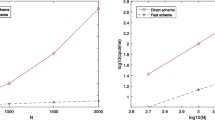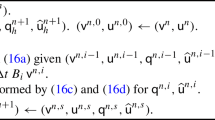Abstract
In this work, the time-fractional Tricomi equation is investigated via two efficient computational techniques. This equation is used to explain the nearly sonic speed gas dynamics phenomenon. The Homotopy perturbation transform technique, which is a combination of Laplace transform and a semi-analytical technique, and Homotopy analysis method are used to solve the time-fractional Tricomi equation. The existence and uniqueness of the solution is analyzed by using two different fixed-point theorems. Finally, the effectiveness of the proposed techniques is illustrated through two test examples by comparing the absolute error of proposed techniques with the existing techniques and the result achieved in this paper benefits (but not limited to) the gas flow dynamics.












Similar content being viewed by others
References
Podlubny I 1999 Fractional Differential Equations New York Academic Press San Diego. 1–366
Atangana A and Khan M A 2020 Modelling and analysis of competition model of bank data with fractal-fractional Caputo-Fabrizio operator. Alex. Eng. J. 59: 1985–1998
Mohan L and Prakash A 2024 Stability and numerical analysis of fractional BBM-Burger equation and fractional diffusion-wave equation with Caputo derivative. Opt. Quant. Electron. 1–25. DOI: https://doi.org/10.1007/s11082-023-05608-9
Izadkhah M M and Saberi-Nadjafi J 2015 Gegenbauer spectral method for time-fractional convection–diffusion equations with variable coefficients. Math. Methods Appl. Sci. 38: 3183–3194. https://doi.org/10.1002/mma.3289
Mashayekhi S and Razzaghi M 2016 Numerical solution of the fractional Bagley-Torvik equation by using hybrid functions approximation. Math. Methods Appl. Sci. 39: 353–365. https://doi.org/10.1002/mma.3486
Prakash A and Kaur H 2022 Numerical simulation of coupled fractional-order Whitham-Broer-Kaup equations arising in shallow water with Atangana-Baleanu derivative. Math. Methods Appl. Sci.. https://doi.org/10.1002/mma.8238:1-20
Prakash A and Mohan L 2023 Application of Caputo fractional operator to analyse the fractional model of Brain Tumour via modified technique. Int. J. Appl. Comput. Math. 9: 1–33. https://doi.org/10.1007/s40819-023-01591-7
Mohan L and Prakash A 2023 Stability and numerical analysis of the generalised time-fractional Cattaneo model for heat conduction in porous media. Eur. Phys. J. Plus 138: 294. https://doi.org/10.1140/epjp/s13360-023-03765-0
Chaudhary K S and Kumar N 2023 Fractional order fast terminal sliding mode control scheme for tracking control of robot manipulators. ISA Trans. 142: 57–69. https://doi.org/10.1016/j.isatra.2023.08.008
Mohan L and Prakash A 2023 An efficient technique for solving fractional diffusion equation arising in oil pollution via Natural transform. Waves Random Complex Media 2273323: 1–24. https://doi.org/10.1080/17455030.2023.227332
Kumar S, Kumar A and Abbas S 2020 A modified analytical approach with existence and uniqueness for fractional Cauchy reaction–diffusion equations. Adv. Differ. Equ. 28: 1–19
Jleli M, Kumar S, Kumar R and Samet B 2020 Analytical approach for time fractional wave equations in the sense of Yang-Abdel-Aty-Cattani via the homotopy perturbation transform method. Alex. Eng. J. 59(5): 2859–2863
Khan M A, Ullah S and Kumar S 2021 A robust study on 2019-nCOV outbreaks through non-singular derivative. Eur. Phys. J. Plus 136(168): 1–20
Kumar S, Chauhan R P, Momani S and Hadid S 2020 Numerical investigations on COVID-19 model through singular and non-singular fractional operators. Numer. Methods Partial Differ. Equ. 1–27. https://doi.org/10.1002/num.22707
Kumar S, Kumar A, Samet B and Dutta H 2021 A study on fractional host–parasitoid population dynamical model to describe insect species. Numer. Methods Partial Differ. Equ. 37(2): 1673–2169
Kumar S, Ghosh S, Kumar R and Jleli M 2021 A fractional model for population dynamics of two interacting species by using spectral and Hermite wavelets methods. Numer. Methods Partial Differ. Equ. 37(2): 1652–1672
Cimmino G 1938 Sulle equazioni lineari alle derivative parziali del secondo ordine di tipo ellittico sopra una surface chiusa. Annali della Scuola Normale Superiore di Pisa-Classe di Scienze. 7: 73–96
Frankl F 1947 On the problems of Chaplygin for mixed sub-and supersonic flows. Bulletin de L'Academie des Sciences de L'URSS. 9: (NACA-TM-1155)
Bers L 2016 Mathematical aspects of subsonic and transonic gas dynamics. Courier Dover Publications
Morawetz C S 2004 Mixed equations and transonic flow. J. Hyperbol. Differ. Equ. 1: 1–26
Nocilla S 1986 Applications and developments of the Tricomi equation in the transonic aerodynamics. Mixed Type Equ. 90: 216–241
Kim J 1999 An a priori estimate for the Tricomi equation in the upper half space. Trans. Am. Math. Soc. 351: 4611–4628
Lupo D and Payne K R 2002 Spectral bounds for Tricomi problems and application to semilinear existence and existence with uniqueness results. J. Differ. Equ. 184: 139–162
Payne K R 1996 Interior regularity of the Dirichlet problem for the Tricomi equation. J. Math. Anal. Appl. 199: 271–292
Yagdjian K 2004 A note on the fundamental solution for the Tricomi-type equation in the hyperbolic domain. J. Differ. Equ. 206: 227–252
Zhang X D, Liu J, Wen J, Tang B and He Y N 2013 Analysis for one-dimensional time-fractional Tricomi-type equations by LDG methods. Numer. Algorithms 63: 143–164
Zhang X D, Huang P, Feng X and Wei L 2013 Finite element method for two-dimensional time-fractional tricomi-type equations. Numer. Methods Partial Differ. Equ. 29: 1081–1096
Liu J, Li H, Liu Y and Fang Z 2016 Reduced-order finite element method based on POD for fractional Tricomi-type equation. Appl. Math. Mech. 37: 647–658
Dehghan M and Abbaszadeh M 2017 Element free Galerkin approach based on the reproducing kernel particle method for solving 2D fractional Tricomi-type equation with Robin boundary condition. Comput. Math. Appl. 73: 1270–1285
Liao S 2004 On the homotopy analysis method for nonlinear problems. Appl. Math. Comput. 147: 499–513
Belgacem R, Baleanu D and Bokhari A 2019 Shehu transform and applications to Caputo-fractional differential equations. Int. J. Anal. Appl. 17: 917–927
Ziane D, Belghaba K and Cherif M H 2015 Fractional homotopy perturbation transform method for solving the time-fractional KdV, K (2, 2) and Burgers equations. Int. J. Open Prob. Comput. Sci. Math. 8: 63–75
Kumar K, Pandey R K and Sharma S 2017 Comparative study of three numerical schemes for fractional integro-differential equations. J. Comput. Appl. Math. 315: 287–302
Palais R S 2007 A simple proof of the Banach contraction principle. J. Fixed Point Theory Appl. 2: 221–223
Green J W and Valentine F A 1961 On the arzela-ascoli theorem. Math. Mag. 34: 199–202
Garcia-Falset J, Latrach K, Moreno-Gálvez E, Taoudi M A and Schaefer-Krasnoselskii, 2012 fixed point theorems using a usual measure of weak noncompactness. J. Differ. Equ. 252: 3436–3452
Verma P and Kumar M 2020 An analytical solution of linear/nonlinear fractional-order partial differential equations and with new existence and uniqueness conditions. Proc. Natl. Acad. Sci. India Sect. A Phys. Sci.: 1–9
Author information
Authors and Affiliations
Corresponding author
Rights and permissions
Springer Nature or its licensor (e.g. a society or other partner) holds exclusive rights to this article under a publishing agreement with the author(s) or other rightsholder(s); author self-archiving of the accepted manuscript version of this article is solely governed by the terms of such publishing agreement and applicable law.
About this article
Cite this article
Mohan, L., Prakash, A. Two efficient techniques for analysis and simulation of time-fractional Tricomi equation. Sādhanā 49, 161 (2024). https://doi.org/10.1007/s12046-024-02482-3
Received:
Revised:
Accepted:
Published:
DOI: https://doi.org/10.1007/s12046-024-02482-3




